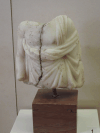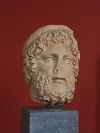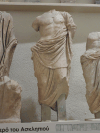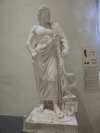
View of the Sanctuary of Asclepius from the west, from Messene, Greece. (1283k)
From the Asclepius entry in Wikipedia:
Asclepius is a hero and god of medicine in ancient Greek religion and mythology. He is the son of Apollo and Coronis, or Arsinoe, or of Apollo alone. Asclepius represents the healing aspect of the medical arts; his daughters are Hygieia ("Health, Healthiness"), Iaso (from ἴασις "healing, recovering, recuperation", the goddess of recuperation from illness), Aceso (from ἄκεσις "healing", the goddess of the healing process), Aegle (the goddess of good health) and Panacea (the goddess of universal remedy). He has several sons as well. He was associated with the Roman/Etruscan god Vediovis and the Egyptian Imhotep. He shared with Apollo the epithet Paean ("the Healer (through magic)"). The rod of Asclepius, a snake-entwined staff, (similar to the caduceus) remains a symbol of medicine today. Those physicians and attendants who served this god were known as the Therapeutae of Asclepius.
All pictures are © Dr. Günther Eichhorn, unless otherwise noted.
God of medicine, healing, rejuvenation and physicians
Asclepius was the son of Apollo and, according to the earliest accounts, a mortal woman named Coronis. When she displayed infidelity by sleeping with a mortal named Ischys, Apollo realized this with his prophetic powers and killed Ischys. Coronis was killed by Artemis for being unfaithful to Apollo and was laid out on a funeral pyre to be consumed, but Apollo rescued the child by cutting him from Coronis' womb.
According to Delphian tradition, Asclepius was born in the temple of Apollo, with Lachesis acting as a midwife and Apollo relieving the pains of Coronis. Apollo named the child after Coronis' nickname, Aegle.
Phoenician tradition maintains that Asclepius was born of Apollo without any woman involved.
According to the Roman version, Apollo, having learned about Coronis' betrayal with the mortal Ischys through his raven, killed her with his arrows. Before breathing her last, she revealed to Apollo that she was pregnant with his child. He repented his actions and unsuccessfully tried to save her. At last, he removed their son safely from her belly before she was consumed by the fire.
In yet another version, Coronis who was already pregnant with Apollo's child, had to accompany her father to Peloponnesos. She had kept her pregnancy hidden from her father. In Epidaurus, she bore a son and exposed him on a mountain called Tittheion (from τίτθη "wet nurse", τιτθεύω "to suckle, breastfeed"). The child was given milk by one of the goats that pastured about the mountain, and was guarded by the watch-dog of the herd. Aresthanas, the owner of goats and the guard dogs found the child. As he came near, he saw lightning that flashed from the child, and thinking of it to be a sign of divine, he left the child alone. Asclepius was later taken by Apollo.
Apollo named the rescued baby "Asclepius" and reared him for a while and taught him many things about medicine. However, like his half-brother, Aristaeus, Asclepius had his formal education under the centaur Chiron who instructed him in the art of medicine.
It is said that in return for some kindness rendered by Asclepius, a snake licked Asclepius's ears clean and taught him secret knowledge (to the Greeks snakes were sacred beings of wisdom, healing, and resurrection). Asclepius bore a rod wreathed with a snake, which became associated with healing. Another version states that when Asclepius (or in another myth Polyidus) was commanded to restore the life of Glaucus, he was confined in a secret prison. While pondering on what he should do, a snake crept near his staff. Lost in his thoughts, Asclepius unknowingly killed it by hitting it again and again with his staff. Later, another snake came there with a herb in its mouth, and placed it on the head of dead snake, which soon came back to life. Seeing this, Asclepius used the same herb, which brought Glaucus back. A species of non-venomous pan-Mediterranean serpent, the Aesculapian snake (Zamenis longissimus) is named for the god.
He was originally called Hepius but received his popular name of Asclepius after he cured Ascles, ruler of Epidaurus who suffered an incurable ailment in his eyes. Asclepius became so proficient as a healer that he surpassed both Chiron and his father, Apollo. Asclepius was therefore able to evade death and to bring others back to life from the brink of death and beyond. This caused an excessive abundance of human beings, and Zeus resorted to killing him to maintain balance in the numbers of the human population.
At some point, Asclepius was among those who took part in the Calydonian Boar hunt.
Asclepius was married to Epione, with whom he had five daughters: Hygieia, Panacea, Aceso, Iaso, and Aegle, and three sons: Machaon, Podaleirios and Telesphoros. He also sired a son, Aratus, with Aristodama. Death and resurrection as a god
Asclepius once started bringing back to life the dead people like Tyndareus, Capaneus, Glaucus, Hymenaeus, Lycurgus and others. Others say he brought Hippolytus back from the dead on Artemis' request, and accepted gold for it. It is the only mention of Asclepius resurrecting the dead. In all other accounts he is said to use his skills simply as a physician.
However, Hades accused Asclepius for stealing his subjects and complained to his brother Zeus about it. According to others, Zeus was afraid that Asclepius would teach the art of resurrection to other humans as well. So he killed Asclepius with his thunderbolt. This angered Apollo who in turn killed the Cyclopes who made the thunderbolts for Zeus. For this act, Zeus banished Apollo from Olympus and commanded him to serve Admetus, King of Thessaly, for a year. After Asclepius's death, Zeus placed his body among the stars as the constellation Ophiuchus ("the Serpent Holder").
Later, however, upon Apollo's request, Zeus resurrected Asclepius as a god and gave him a place on Olympus.






This page contains 6 pictures
Here are the links to the other main pages on Greece:
Page last updated on Tue Aug 16 15:07:42 2022 (Mountain Standard Time)
Asclepius on aerobaticsweb.org